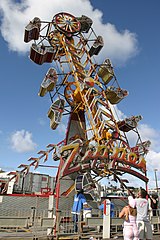How safe are the local ferris wheels at the carnival or the big roller coasters at the family fun amusement parks? Good question. Today, there is no federal oversight of many amusement park rides; the safety (or risk) of amusement park rides depends upon the law of each state, and state laws vary.
Consumer Product Safety Commission No Longer Polices Safety of Roller Coasters or Other Amusement Park Rides
There was a time when the Consumer Product Safety Commission (CPSC) acted as federal oversight into the safety of amusement parks and potentially deadly amusement park rides like big, heavy, and high-speed roller coasters; for example, in 1977 the CPSC filed a federal lawsuit against a Kansas company that manufactured an amusement park ride called “the Zipper” because over a 4-year period, four people had died when “the Zipper” door locks failed, and the doors sprang open while the riders were in mid-air.
If this sounds familiar, it should. By some news accounts, allegedly a similar lock failure recently caused a woman to fall 75 feet to her death while riding a roller coaster called “the Texas Giant” at Six Flags Over Texas in Dallas.
However, lawsuits were filed against the CPSC arguing that the federal agency lacked the power to monitor amusement park rides because these things did not come within the definition of “product” as defined in the agency’s enabling statutes. Federal courts agreed, and since fixed amusement rides were held not to be “consumer products” the Consumer Product Safety Commission was denied the ability to check into the safety (or danger) of amusement rides at the federal level.
States Control Safety of Fixed Amusement Park Rides on a State-by-State Basis
Since then, no other federal agency has taken up the reins and the determination of how safe (or dangerous) a fixed amusement ride may be is within the jurisdiction of the individual states.
Which means that stationary amusement rides, like the big roller coasters in the bigger parks, are inspected by the State Officials for the particular state in which they sit; for amusement rides that are portable — that can be dismantled and trucked from one location to another (like the Zipper) — different state agencies may have different opinions on how hazardous that particular ride may be, and different standards for safety and maintenance, etc. but the CPSC does maintance jurisdiction over these rides.
The Commission has jurisdiction only over mobile amusement rides, i.e. those rides transported from location to location. According to the best available information, eight states do not have state administered inspection programs for mobile rides; and eight states and the District of Columbia do not have state administered inspection programs for fixed-site rides. While authority under each state’s legislation differs, the main purpose is to prevent deaths and injuries on amusement rides through the early identification of unsafe and defective rides.
For example, in Texas, it is the Texas Department of Insurance that is responsible for inspecting amusement rides for safety and insuring that they are in compliance with state safety regulations. According to a Department of Insurance representative, at the time of the tragic death involving the Texas Giant roller coaster, the Six Flags amusement park was found to be following Texas law because it had had an annual inspection performed by an approved engineer and it carried the required $1 million liability insurance coverage on each of its rides.
Amusement Park Rides in Indiana and Illinois: Annual Inspections
Today, news reports are that the Indiana Department of Homeland Security will be inspecting all the amusement rides at the Indiana State Fair (which begins tomorrow). That’s because in the State of Indiana, the Amusement Ride Division of the Indiana Department of Homeland Security is the agency responsible for inspecting amusement rides in the state.
Indiana Amusement Revised Code Title 685 IAC 1 covers amusement rides within the state, and according to Indiana law, rides must be inspected by state officials on their first “setup” each year and can be re-inspected with each new “setup.”
In the State of Illinois, Illinois Carnival & Amusement Rides Safety Act (Illinois Compiled Statutes 430 ILCS 85/2-1 et seq.) applies to amusement rides, along with Title 56, Labor and Employment Chapter XIII: Carnival-Amusement Safety Board, Part 6000:Carnival & Amusement Ride Inspection Law. The agency that handles this job is the Illinois Department of Labor, Carnival and Amusement Ride Inspection Division.
Illinois law requires an annual inspection of amusement rides, amusement attractions, ski lifts, rope tows, go-carts & bungee cord devices. Follow-up inspections can happen, but they’re not required to have advanced notice to the park.
For more information, see the CPSC site listing of Amusement Park Safety Oversight by State.


